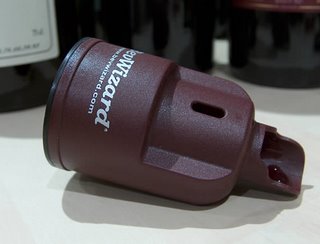Magnets and wine revisited
 I've just had a couple of news pieces on the magnets and wine story published: a short one in Decanter and a longer one in Harpers (you'll need to be a subscriber to access this one).
I've just had a couple of news pieces on the magnets and wine story published: a short one in Decanter and a longer one in Harpers (you'll need to be a subscriber to access this one).I've also tried the BevWizard (pictured) at home, and I'm ashamed to say that my palate must be pretty bad because I couldn't spot any difference between the treated and untreated wines. David Bird MW and I have been discussing arranging a controlled, blind tasting of the device. I'll keep you posted. Some time next week I'll also be publishing a longer article on the subject on this site.
Some further reading: Ben Goldacre's take on another wine magnet device is here. There's a copy of the very funny Rubin et at study here.
Labels: magnets and wine


3 Comments:
That's really interesting Jamie!
James Cluer and I were on an MW course together a couple of years ago. He passed both parts of the exams well before me. We lost contact and I wondered what had happened to him.
Like a lot of people I will also be very interested in the results.
Paul, I'll see if we can get him to share them, once the IMW have passed his dissertation.
Quote Article from www.glug.com.au - by David Farmer
There are several devices on the market that use magnets to improve the taste of wine. They can make rough wines smoother and fruitier and young wines take on desirable aged characters. That at least is what they claim.
The Bev Wizard, retailing at U.S. $30, is the invention of Patrick Farrell. From tying magnets to the neck of a bottle he graduated to the final product, a moulded plastic device that looks like a regular non-drip pourer and has an air hole to speed up oxygenation.
Another is The Wine Clip, which clasps around the bottle neck. More complex is the Perfect Sommelier which "consists of two units containing magnets; a heavy thick circular base, like a wine coaster, on which the opened wine bottle is placed, and a top that sits in the opened neck of the bottle".
Our favourite though is the Wine Enhancer which we wrote about previously in December, 2005
This devise is not based on magnets and works with crystals by "collecting this natural energy, amplifies and then broadcasts these life supporting energies in an organized coherence through the top centre of the devices or back centre of the mini wine enhancer into whatever is placed in contact of it."
As is normal with these devices the advertising brochures and product puffs are sprinkled with just enough quotes from authority figures to give the product credibility. There is always someone who should know better who will endorse a product and which illustrates the power of third party endorsements in selling items.
Of ongoing interest is the ingenuity shown to come up with useless products designed to get us to part with our hard earned money. The wine business has as many contraptions as any other business area from outrageously shaped glasses to millionaire corkscrews and waiters friends so who can get too worried about magnetic enhancers.
Also these devices demonstrate how susceptible we all are to imagining things in wine and how the most subtle outside influence can sway our ideas about wines. In the hands of a master you would have to show steely determination not to believe the magnetic device was not working. My experience suggests you can get tasters to see anything if you set the tasting up correctly.
What a field day the master spoon bender Uri Geller would have running a wine tasting; then again he would be too expensive to show us the art of the magician.
Reading about the magic of magnets Iím left with a puzzle and that is why do the promoters of these products tell us they only work with lower priced wines? There must be a great insight into selling and marketing in this but I cannot see it
Post a Comment
Links to this post:
Create a Link
<< Home